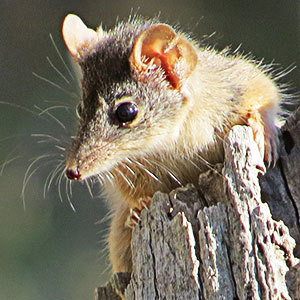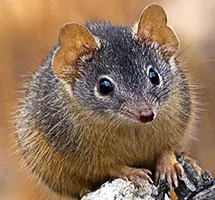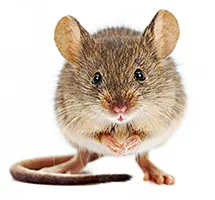Antechinus: The Sex Crazy Marsupial

Contents
What is an Antechinus?
The antechinus is a mouse-like Australian marsupial with a hectic sex life. It is roughly the shape, size, and appearance of a house mouse. Measuring 9–120mm long and weighing 17-71gm, it has short, stiff grey, brown, black, and golden fur with underbellies of beige or white. The antechinus has long snouts, four pairs of sharp teeth, bulging dark brown eyes, and pink to light brown nostrils. A distinguishing feature is its notched ears, making them appear like double ears. Males are larger than females. The male mates itself to death and, therefore, reproduces only once in its lifetime.
Antechinus vs Mouse: Key Differences
People frequently confuse the antechinus with a house mouse. The key differences are:
Antechinus

Antechinus
- The antechinus is marsupial mammal that carry its babies in a pouch on its bellies.
-
Has many sharp teeth.
-
Has five-clawed toes on their front feet and four clawed toes on their rear feet.
-
Has rounded, crinkly ears that look like double-ears.
-
Its tail is fur-covered instead of scaly.
House Mouse

House Mouse
- The house mouse is a placental mammal.
-
It has chisel-shaped front teeth.
-
Has four-clawed toes on each front foot plus a clawless. insignificant thumb.
-
It has a five-clawed toes on its rear feet.
-
It has smooth rounded ears and a scaly tail.
- The house mouse is not native to Australia. It was introduced to Australia by European settlers in 1788.
How the Antechinus Got its Name

The scientific name Antechinus (pronounced ant·echi·nus) is derived from the Greek words anti (“not”) and ekhinos (“hedgehog”). Although the antechinus has a pointy nose and bristly fur like a hedgehog, it is definitely not a placental mammal like the hedgehog. So 'Antechinus' means — not a hedgehog.
Where does the Antechinus Live?

Photo: Antechinus size compared to a human hand
Antechinuses live in temperate and tropical forests, woodlands, and swamps on the east coast of Australia. There is also a small population in southwest Western Australia. Most are ground-dwelling, though some are arboreal and live in trees.
- They are solitary, territorial animals that will actively defend their territories.
- Most antechinuses are nocturnal, meaning they come out when it is dark.
- Most antechinus species nest communally in tree hollows. Up to 20 may share a nest.
What Do Antechinus Eat?

Photo: Antechinus feeding
Antechinuses are voracious insectivores. Their sharp teeth, speed, and agility enable them to overwhelm creatures much larger than themselves. They feed on:
- Spiders, weevils, beetles, and worms.
- Insect larvae
- Small reptiles and frogs
- Occasionally fruit, flowers, and nectar.
- They have an unusual habit of neatly turning small bony animals' skins inside out while eating them.
Antechinus Reproduction: Mating to Death
Males: Sex-Fueled Suicide
Antechinus males have a suicidal reproduction strategy called semelparity or "big-bang" reproduction. Males breed only once in their lifetimes and then die. They:
- Will mate for up to 14 hours at a time
- Do not eat, sleep, or groom
- Their Immune systems collapse and organs break down from exhaustion
- All males die after the breeding season.
- The lifespan of a male antechinus is typically only one year.
Female Antechinus
Antechinus females live up to 3 years. They:
- Mate with multiple males
- Store the sperm from multiple male partners
- Releases
her eggs only at the end of the mating period
- these eggs are fertilised by the sperm she has held in storage.
-
As a result, her eggs are fertilised by sperm from multiple males, and her litter will have multiple fathers.
- The gestation period is approximately one month and she has a litter of up-to 14 young.
Antechinus Babies

Photo: Antechinus babies in mother's pouch
Antechinus babies are the tiniest of Australian native animal babies.
- When born, they are just 4-5 mm in length (That's smaller than a grain of rice!) and weigh an average of 0.016gm.
- They are born blind, hairless, with stumpy forelimbs and hardly any fur.
- The babies crawl vigorously to their mother's pouch which has only about eight nipples.
- Only those babies who successfully latch onto one of her available nipples survive.
-
The others quickly die and fall off.
-
The young are fully independent when they are about three months old, at which time most mothers die.
Antechinus Species
There are 15 species of antechinuses in Australia. The most common are the Yellow-footed, Agile, Dusky and Brown antechinuses.
Yellow-footed Antechinus

Photo: Yellow-footed Antechinus

Photo: Yellow-footed Antechinus Habitat Map
The yellow-footed antechinus (Antechinus flavipes) has a variable fur colour depending on its habitat. It usually has a grey upper body with a golden-brown belly, white eye rings, and a black-tipped tail. It has broad yellowish feet — hence its name, yellow-footed antechinus. Its body is about 10-16 cm long with a tail of an additional 10cm. The male weighs around 30gm and the female 28gm. It has a jerky movement.
The yellow-footed antechinus lives mainly along the north-eastern and, to a lesser extent, the south-eastern parts of Australia. A small pocket is also found in the southernmost parts of Western Australia. A tiny population lives in South Australia, where they are considered endangered. The yellow-footed antechinus is a terrestrial animal preferring to scamper about the leaf litter forests, heath, woodlands, and coastal plain. It is the most widespread antechinus species. It is active mainly during the day.
Agile Antechinus

Photo: Agile Antechinus

Photo: Agile Antechinus Habitat Map
The agile antechinus (Antechinus agilis) is the smallest of all antechinus. It has a body length of 8–11cm and a bristly tail of 11cm. It weighs 16-44gm. This antechinus has greyish brown upper body fur and pale under-body fur. It has lightly coloured fur forming narrow rings around its eyes. Until 1980, it was classified as a member of the brown antechinus species, but DNA tests determined that it was a species of its own. It is a nocturnal insectivore. The female gives birth to a litter of between 6–8 babies. The female gives birth to a litter of between 6–8 babies.
The agile antechinus is a ground-dwelling marsupial that lives amongst dense leaf litter and fallen logs in the forests of south-eastern Australia. It nests in log hollows and crevices where up to 20 individuals may share a single nest.
Brown Antechinus

Photo: Brown Antechinus

Photo: Brown Antechinus Habitat Map
The brown antechinus (Antechinus stuartii) is a nocturnal mostly arboreal antechinus. That is, it is active at night and lives mostly in trees. As a result, it is an excellent climber. The fur on its upper body is brown, and its underbelly is usually white or beige. It has a body length of 7–14cm, and its tail is about 11cm and is mostly hairless. It weighs 16–44 grams. Unlike other antechinuses, it doesn't have pale-coloured eye rings. This antechinus is known to go into a torpor where it can drop its body temperature to 11–25 degrees and reduce its metabolic rate by up to 60% to conserve energy in times of starvation.
The brown antechinus lives in wooded habitats east of the Great Dividing Range in Australia. Females share communal nests.
Dusky Antechinus

Photo: Dusky Antechinus

Photo: Dusky Antechinus Habitat Map
The dusky antechinus (Antechinus swainsonii) is the largest species of antechinus. Its fur is dark grey to black. Its body is 9–18cm long with a tail that is 8-12cm long. The male weighs about 65gm and the female 41gm. It is a nocturnal insectivore but may also be active during the day. The female gives birth to a litter of between 6–8 babies.
This ground-dwelling marsupial lives in alpine heath or forest with dense fern or shrub under-storey along the eastern coast of Australia and on the island of Tasmania. During the day, it rests in a nest in a hollow log or hidden in ground litter or vegetation.
Antechinus Predators and Threats
Antechinus fall prey to:
-
Snakes and lizards
- Foxes, dingoes, feral cats,domestic cats and dogs
- large birds
- Habitat loss due to deforestation
Is the Antechinus Endangered?
The antechinus is not endangered. It is protected in all states of Australia.
Learn More About Australia's Incredibly Quirky Animals
All Rights Reserved. (Last Updated: Jun 16, 2025)